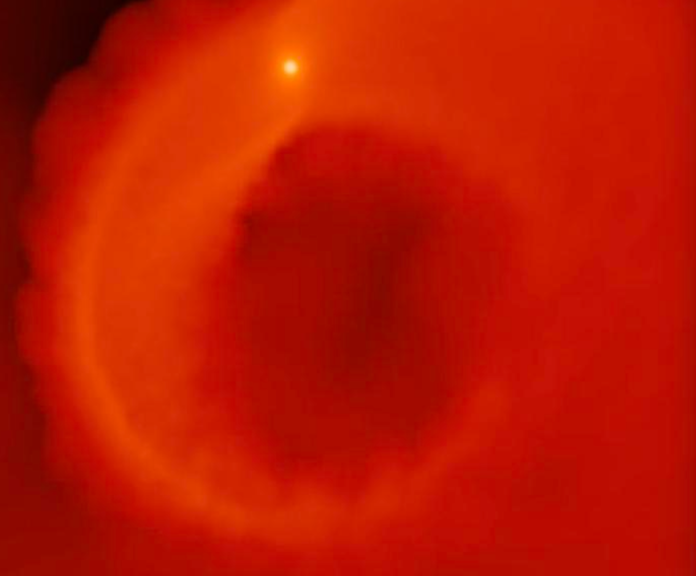Scientists have found a new explanation for a massive star ‘s 85-year-old flare , which is a trillion times more powerful than the largest of the flares from the sun and that is tearing apart a planet larger than Jupiter . Researchers, including those from the University of Leicester UK, said the planet that is about 10 times larger than Jupiter is undergoing ‘extreme evaporation’ near a star, whose inferno is tearing material off of it and flinging it onto the star. The study, published in the journal Monthly Notices of the Royal Astronomical Society, sheds more light on the formation of stars and also suggests such giant flares in developing solar systems may lead to a dozen planet elimination events. In the research, scientists assessed the protostar FU Ori, located about 1,200 light years from our Solar System, which has significantly increased in brightness after 85 years – and has still not dimmed. Researchers suspect the increase in the protostar’s brightness could be due to material falling onto it from a cloud of planet-forming gas and dust called a protoplanetary disc. ‘These discs feed growing stars with more material but also nurture planets. Previous observations provided tantalizing hints of a young massive planet orbiting this star very close,’ study co-author Sergei Nayakshin said. ‘We discovered a new process which you might call a ‘disc inferno’ of young planets,’ Dr Nayakshin said. Scientists simulated a gas giant planet formed far out in the disc by gravitational instability in which a massive disc breaks apart to make huge clumps more massive than Jupiter, but far less dense. The modelling suggests such a planetary seed tends to migrate inward towards its host star very rapidly due to its gravitational pull. The ultra-hot material around the star would then ignite the outer layers of the planet’s atmosphere as it draws close by about a tenth of the distance between Earth and our own sun . Fragments of the planet then becomes a massive source of material feeding the star, causing it to grow and shine brighter. ‘This was the first star that that was observed to undergo this kind of flare. We now have a couple dozen examples of such flares from other young stars forming in our corner of the Galaxy,’ said Vardan Elbakyan, another author of the study. ‘While FU Ori events are extreme compared to normal young stars, from the duration and observability of such events, observers concluded that most emerging solar systems flare up like this a dozen or so times while the protoplanetary disc is around,’ Dr Elbakyan said. Researchers said the findings have broad implications for understanding both star and planet formation. Protoplanetary discs, thought to be planet nurseries , may not be the quiet places as was previously imagined, but instead violent and chaotic parts of the cosmos where young planets may get burned and eaten by their stars .
Mystery unraveled of stellar flare so powerful it’s ‘evaporating’ a planet nearby
Sourceindependent.co.uk
RELATED ARTICLES


